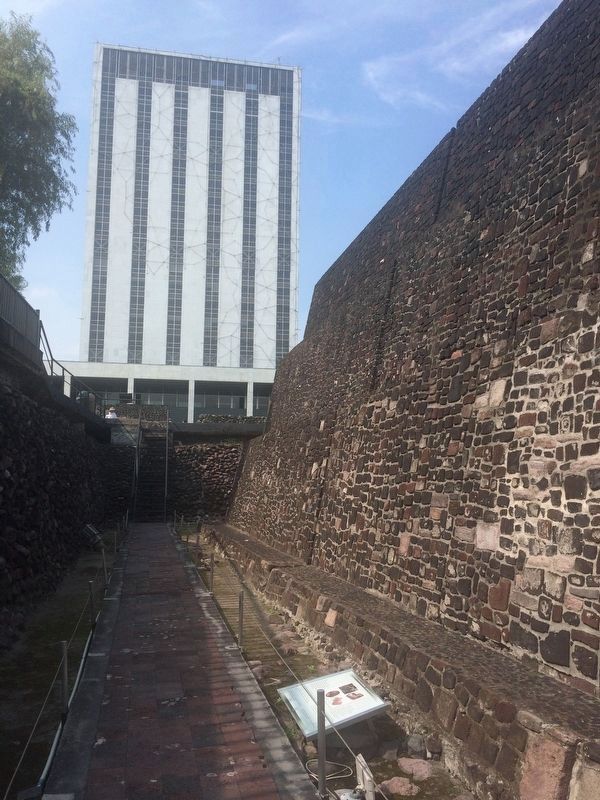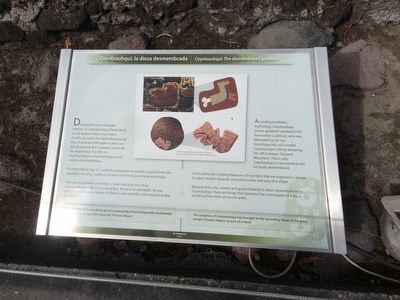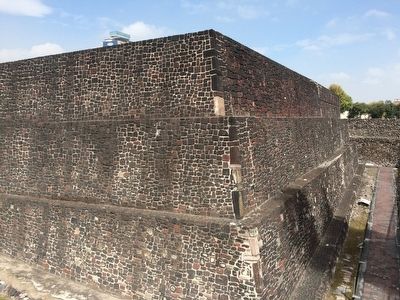Colonia Tlatelolco in Ciudad de México, Mexico — The Valley of Mexico (The Central Highlands)
Coyolxauhqui: The dismembered goddess
Coyolxauhqui: la diosa desmembrada
De acuerdo a la mitología mexica, la Coyolxauhqui (Diosa de al Luna) quería matar a su madre Coatlicue, quien fue defendida por su hijo Huitzilopochtli quien acabó con ella al lanzarla de Coatepec (cerro de las serpientes). Por ello, la Coyolxauhqui es representada con el cuerpo desmembrado.
En este edificio hay 151 símbolos grabados en piedra cuyas formas son espirales, círculos, cuadros, círculos concéntricos y líneas onduladas.
Pero por su tamaño, contenido y gran similitud con otras representaciones de la Coyolxauhqui, destaca un petroglifo de una pierna que exhibe la cabeza del fémur, una sandalia y dos bandas arriba del tobillo.
Posiblemente la escultura de la Coyolxauhqui fue incorporada ritualmente como parte de la segunda etapa del Templo Mayor.
Pie de dibujo:
La Diosa Coyolxauhqui fue hija de la Cuatlicue y hermana de Huitzilopochtli, dios de sol y de la guerra.
According to Mexica mythology, Coyolxauhqui (moon goddess) wanted to kill her mother Coatlicue, who was defended by her son Huitzilopochtli, who ended Coyolxauhqui's life by throwing her off Coatepec (Serpent Mountain). That is why Coyolxauhqui is represented with her body dismembered.
In this particular building there are 151 symbols that are engraved in stones in spirals, circular, squared, concentric circles and wavy line shape.
Because of its size, content and great similarity to other representations in Coyolxauhqui, there are things that stand out like a petroglyph of a leg, a sandal and two belts above the ankle.
The sculpture of Coyolxauhqui was brought to the secondary stage of the great temple (Templo Mayor) as part of a ritual.
English translation of caption:
The goddess Coyolxauhqui was the daughter of Cuatlicue and sister of Huitzilopochtli, god of the sun and war.
Topics. This historical marker is listed in these topic lists: Anthropology & Archaeology • Man-Made Features.
Location. 19° 27.075′ N, 99° 8.235′ W. Marker is in Ciudad de México. It is in Colonia Tlatelolco. The marker is at the Tlatelolco Archeological Site on Eje Central near the intersection with Avenida Ricardo Flores Magón. Touch for map. Marker is in this post office area: Ciudad de México 06900, Mexico. Touch for directions.
Other nearby markers. At least 8 other markers are within walking distance of this marker. Favor request…and talent for the gods (a few steps from this marker); Battle of Tlatelolco (a few steps from this marker); Stage 1 of the Templo Mayor de Mexico Tlatelolco
(within shouting distance of this marker); Santiago Church (within shouting distance of this marker); Tlatelolco’s great temple (“Templo Mayor”): A mirrored image of Tenochtitlan (within shouting distance of this marker); From peaceful convent to bellicose military barracks (within shouting distance of this marker); Full color Tlatelolco: The temple of the paintings (within shouting distance of this marker); Templo Mayor: a temple built eight times (within shouting distance of this marker). Touch for a list and map of all markers in Ciudad de México.

Photographed By J. Makali Bruton, August 7, 2017
3. Coyolxauhqui: The dismembered goddess Marker
The marker can be seen here at the base of the Templo Mayor ruins in this view towards the south. The Secretariat of Foreign Relations building (Secretaría de Relaciones Extranjeras) can be seen in the distance.
Credits. This page was last revised on April 17, 2020. It was originally submitted on January 4, 2016, by J. Makali Bruton of Accra, Ghana. This page has been viewed 527 times since then and 11 times this year. Photos: 1, 2. submitted on January 4, 2016, by J. Makali Bruton of Accra, Ghana. 3. submitted on August 13, 2017, by J. Makali Bruton of Accra, Ghana.

